North Mississippi Research and Extension Center - Annual Report 2021
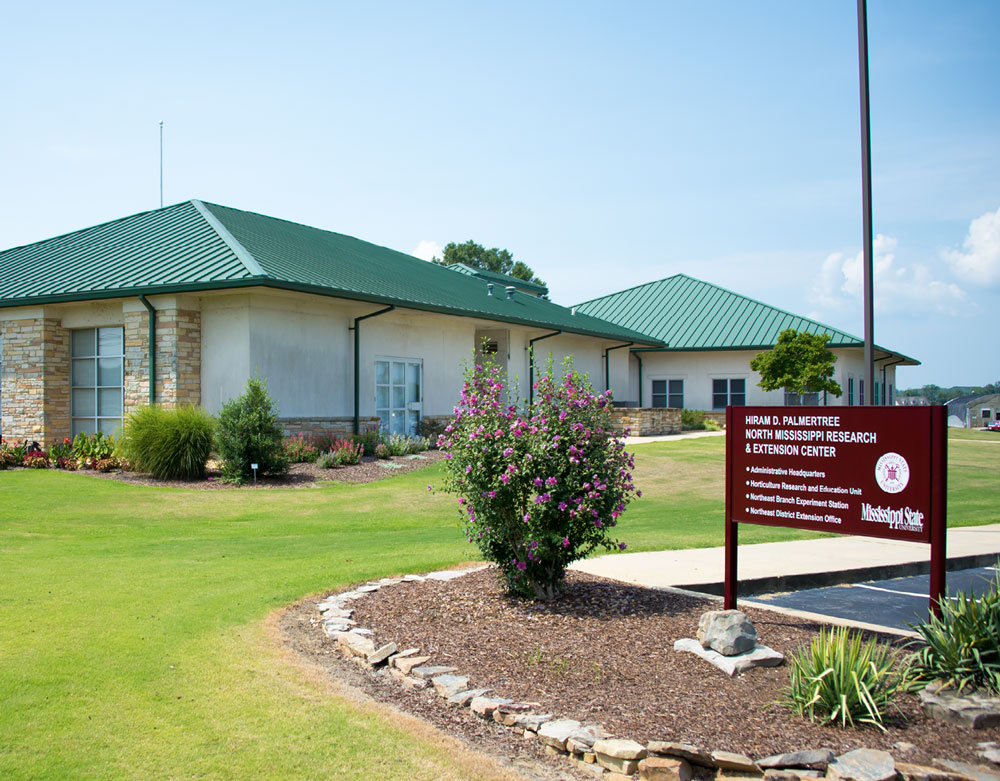
The North Mississippi Research and Extension Center (NMREC) listens to stakeholders’ concerns to conduct research and implement solutions to the everyday challenges Mississippians face. This annual report highlights some of the many research projects and extension programs conducted by faculty and staff in 2021. Research sponsors, stakeholders, and volunteers made valuable contributions and are appreciated for their continued input and support.
As part of the Mississippi State University Division of Agriculture, Forestry, and Veterinary Medicine, NMREC supports the missions of the Mississippi Agricultural and Forestry Experiment Station (MAFES) and the MSU Extension Service, NMREC works to improve the lives of citizens by responding to their needs: collaborating to conduct and share innovative agricultural research; offering practical education for individuals, families, and young people; and serving communities and businesses. As one of four Research and Extension Centers strategically located in the state, NMREC expands upon efforts conducted by the main MSU campus, facilitates research in different soil types and climates, and provides local education and technical assistance to Mississippians.
Researchers based in North Mississippi conduct programs in agronomy, horticulture, animal science, and forestry. NMREC includes four MAFES research locations:
- Northeast Mississippi Branch Experiment Station (Verona)
- Agronomy Unit
- Horticulture Research and Education Unit
- Prairie Research Unit (Prairie)
- Pontotoc Ridge-Flatwoods Branch Experiment Station (Pontotoc)
- North Mississippi Branch Experiment Station (Holly Springs)
Please visit extension.msstate.edu/north-ms-research-and-extension-ctr to contact NMREC or any of its research locations.
Center Update
Advancing agriculture through North Mississippi Research and Extension Center programs
Jane Parish
Throughout 2021, the faculty and staff of the North Mississippi Research and Extension Center were active in a range of research projects and extension programs. Mississippi Agricultural and Forestry Experiment Station (MAFES) branch station scientists and staff engaged in agronomic crops, horticulture, beef cattle, and forestry research to address stakeholder needs. Extension specialists developed and shared research-based information in a variety of ways including hosting field days, providing individualized technical guidance, and expanding online educational resources.
Some research highlights from the year include launching new research projects and enhancing research infrastructure on North Mississippi branch experiment stations. The year 2021 saw the initiation of a sweetpotato breeding program led by newly hired sweetpotato specialist, Dr. Lorin Harvey, at the Pontotoc Ridge-Flatwoods Branch Experiment Station. A new greenhouse was added to support continued efforts servicing the sweetpotato industry through virus-indexed foundation sweetpotato seed slip production. Weed science research in row crops was another major focus of the Pontotoc station. At the Northeast Mississippi Branch Experiment Station in Verona, agronomic research covered important topics such as soil nutrient management, soil moisture monitoring, and iron deficiency chlorosis in soybean. Both the Northeast Mississippi and Pontotoc stations were contributors to the MAFES Official Variety Trials programs for major row crops in the region including corn, soybean, cotton, peanuts, and wheat. Horticulture researchers initiated numerous new experiments in vegetable crops such as lettuce, kale, and cowpea as a new headhouse facility connected to the modern research greenhouse complex neared completion. A new research trial was established at Verona to evaluate different Christmas tree species native to the area as well as different tree management practices. Beef cattle research at the Prairie Research Unit investigated nutritional and health management approaches to improving reproductive and other performance outcomes in cow-calf production. Research began on integrated row crop and cattle enterprises involving soybean production and forage cover crops.
Precision agriculture was a key research focus that spanned agronomic, horticultural, and animal science research efforts in North Mississippi. Continued investments were made in precision agriculture equipment capabilities for row crop research at Verona. This enabled studies such as variable rate nitrogen application trials. Horticultural research addressed precision agriculture management techniques such as precision irrigation. At the Prairie Research Unit, individual animal intake was measured in beef cattle using newly upgraded precision feed intake and behavior measurement systems in both pasture and drylot settings. Future investments in precision agriculture capabilities for agricultural research are underway including expansion of internet service to greenhouse and field areas.
Extension specialists and MAFES scientists shared up-to-date agricultural science with stakeholders on a regular basis. Importantly, in-person field days were held at the MAFES stations in Verona, Pontotoc, and Prairie in 2021 to showcase current information on horticultural crops, row crops, sweetpotato, and beef cattle. This provided growers, producers, and allied industry opportunities to see research in progress firsthand and learn the results of completed research trials along with guidance on how to apply these discoveries to make more informed on-farm management decisions. Other guests hosted at the North Mississippi MAFES stations during the year included MAFES staff from across the state for a multi-day raining conference and the Mississippi Farm Bureau Federation Board of Directors meeting.
An Extension highlight during the year was the statewide Mississippi Master Gardener training program based out of the North Mississippi Research and Extension Center which built upon its previous efforts to offer self-paced online training options. The program was available to anyone with an interest in improving horticultural knowledge and offered opportunities for volunteer service in local communities. Mississippi Master Gardeners contributed more than 53,000 volunteer hours in 2021 valued at over $1.35 million. In addition, horticulture education included hands-on workshops such a pruning training in the demonstration orchard at the Northeast Mississippi Branch Experiment Station. A second year of renovations to the Magnolia Botanical Garden which is also located at Verona was completed in 2021 and included incorporation of new plant materials, educational signage, and innovative garden features. Educational events were routinely held in the garden, and the public was encouraged to explore the garden via self-guided tours.
The research and extension programs put into action by the North Mississippi Research and Extension Center were made possible by the financial support of numerous funding agencies and organizations and by MAFES and Mississippi State University Extension. We are grateful for this support. This annual report is intended to provide an overview of some of these efforts. Additional research projects and extension programs are ongoing and under development. Faculty and staff are available throughout the year to share further details of projects and programs upon request. These experts also help agricultural producers and the general public including youth with technical expertise in agronomy, horticulture, animal science, and forestry. Thank you for taking time to learn more about our 2021 discoveries and educational resources.
Agronomy
Cotton Response to Sulfur and Boron Fertilization
Justin McCoy, Andy Taylor, Mark Harrison, and Mark Murphy
Benefits of sulfur and boron additions in cotton production have been documented throughout literature (Anderson and Boswell, 1968; Kamprath and Jones, 1986). Occurrences of true sulfur (S) deficiencies have become more common as atmospheric deposition of S has decreased in recent years. Boron (B) is a micronutrient required in small amounts that plays an integral role in the cotton reproduction process. Currently Mississippi State recommends annual sulfur and boron fertilization on cotton in soils prone to deficiencies. Producers are often faced with decisions regarding source, rate, and timing of fertilizer applications in these instances.
Field trials were conducted at the North Mississippi Research and Extension Center in 2020 and 2021 to determine cotton response to boron fertilization and in 2021 to determine response to sulfur fertilization. In the Boron trial, applications were made at a rate of 1 lb B acre-1 at plant with either Granubor or Ulexite granular fertilizer; or at first bloom with Solubor foliar fertilizer along with an untreated control receiving no fertilizer. In the sulfur trial, sources of ammonium sulfate (AMS) (21-0-0-24S), MST (Micronized Sulfur Technology, Agrium Inc.) (9-43-0-16S), or a 50/50 blend of AMS+MST were applied at plant at rates of 15 or 20 lb S acre-1 along with an unfertilized control. Cotton plots were treated similarly regarding all other management practices and closely followed University guidelines throughout the growing season.
Lint yield response to Boron fertilization was observed in both years. Lint yield increases following boron fertilization above the nontreated averaged 82 and 125 lb acre-1 in 2020 and 2021, respectively. However, response among sources differed in 2020 with no observed response following a foliar application of Solubor. This observation is likely due to the sustained period of drought following foliar application in 2020. These environmental conditions effectively slowed cotton growth and development, diminishing the circumstances for cotton response due to a foliar application. In 2021, a foliar application of boron performed similarly to granular applications. These observations suggest that timing and environmental conditions should be considered with foliar applications of boron on cotton. If possible, the use of granular fertilizer in-season as a boron source in dryland cotton environments may be preferential.
In the Sulfur trial, lint yield was increased following fertilization above the nontreated regardless of rate or source. Lint yield increases following sulfur fertilization averaged 174 lb acre-1 in 2021. Conditions were favorable throughout the cotton growing season and excellent yields were achieved, creating circumstances for response to supplemental sulfur fertilization. Observations suggest that cotton lint yield response to sulfur fertilization may be significant when the proper sources and rates are applied.
Kamprath, E.J. and Jones, U.S. 1986. Plant Response to Sulfur in the Southeastern United States. In Sulfur in Agriculture, M.A. Tabatabai (Ed.). https://doi.org/10.2134/agronmonogr27.c11
Anderson, O.E. and Boswell, F.C. 1968. Boron and manganese effects on cotton yield, lint quality, and earliness of harvest. Agronomy Journal 60:488-493. https://doi.org/10.2134/agronj1968.00021962006000050014x

Cotton crops flourish at the North Mississippi Research and Extension Center in Verona. (Photos by Justin McCoy)
_-_Cotton_response_-_cotton_flower.png)
_-_Cotton_response_-_spraying.png)
_-_Cotton_response_-_picker.png)
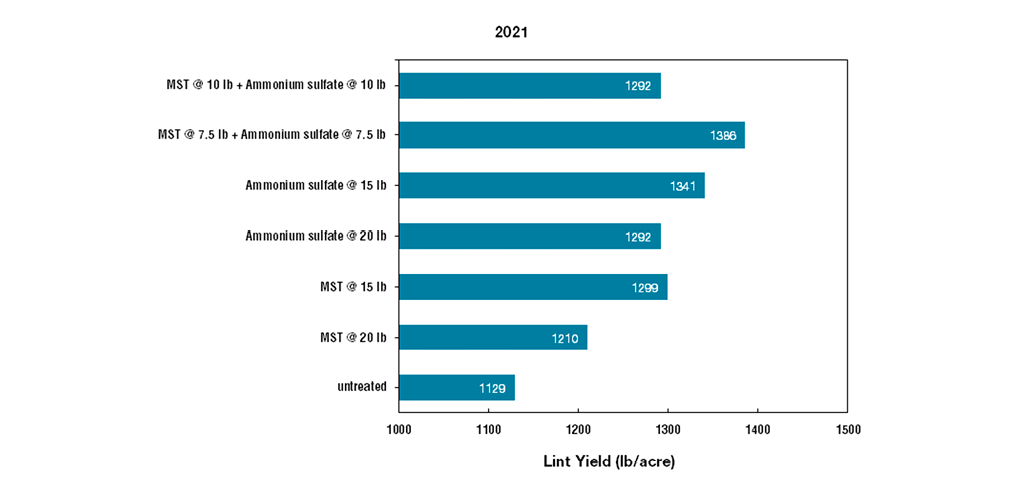
Agronomy
Incorporating Cover Crops into Successful Corn Production Systems
Nolan Mullican, Erick Larson, Justin McCoy, Rocky Lemus, Jason Krutz, Jason Bond, and Will Maples
Cover cropping is an up-and-coming agricultural topic primarily driven by the goal of improving soil health and water quality while simultaneously benefiting our environment. However, despite producing soil, water and conservation benefits, grower acceptance and adoption of cover crops remains quite low. Cover crops may hamper productivity of the subsequent crop due to impairing planting and stand establishment, introducing allelopathy and pest issues, and confounding nutrient availability. Corn is especially vulnerable to any of these issues because it is the first crop planted in the spring, is well-known to be responsive to early planting, and is also extremely sensitive to plant stand variability.
In 2021, and again this year in 2022, field experiments were conducted at the MAFES R. R. Foil Plant Science Farm, Starkville, MS and the MAFES Northeast Mississippi Branch Experiment Station, Verona, MS. Treatments consisted of four different cover crop species: Cereal rye, no cover crop (control), Berseem clover, and a cereal rye + berseem clover mixture. Four different termination timings: 6, 4, 2, and 0 (corn planted into living cover crop) weeks prior to planting were applied to every species treatment.
Cover crop termination timing has a dramatic impact on corn productivity when integrated with cover cropping systems. The presence of living cover crops stunted corn growth and development when they were not terminated by herbicides applied at least two weeks prior to planting. This interference reduced corn grain yield compared to where no cover crops were grown or cover crops which were terminated at least four weeks in advance of planting.
Growing a well-adapted legume species as a cover crop, such as Berseem clover, did improve corn response compared to a monoculture cereal cover crop. Persian clover also demonstrated outstanding potential for use as a cover crop adapted to grow in Mississippi.
_-_Incorporating_-_terminated.png)
Cover crops terminated six weeks prior to planting (left) versus those terminated at planting. (Photo by Nolan Mullican)
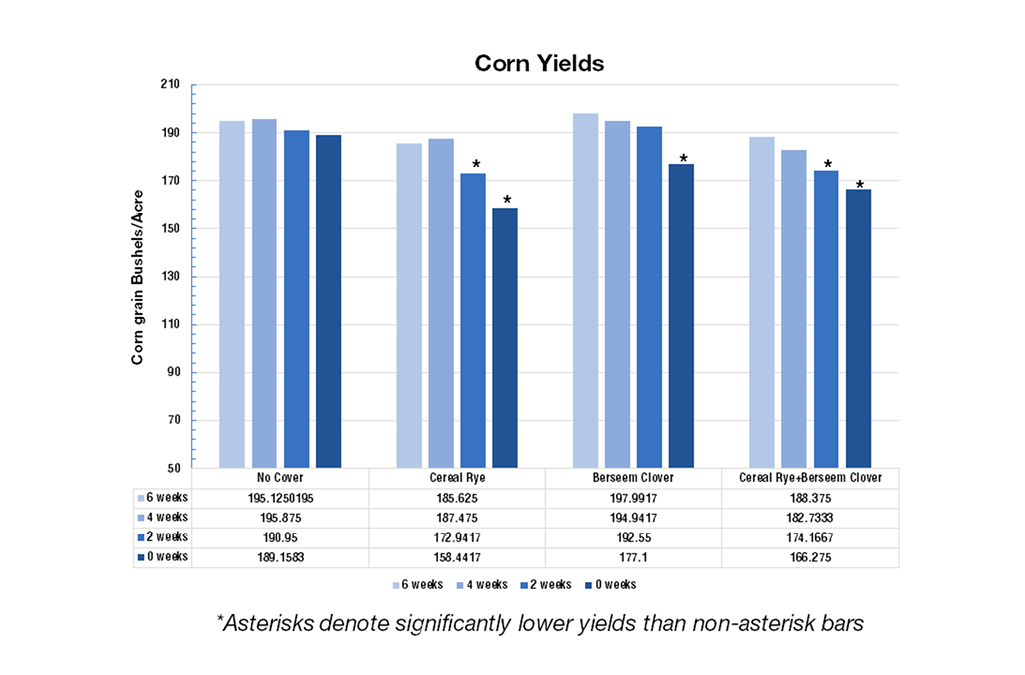
Corn planted in cover crops. (Photo by Nolan Mullican)
_-_Incorporating_-_furrow.png)
Corn with cover crops in the furrow. (Photo by Nolan Mullican)
Agronomy
The CleanSEED Project: A Nationwide Survey to Assess the Needs of the Sweetpotato Industry
Lorin Harvey, Mark Shankle, and Rachael Carter
Sweetpotato is an important specialty crop to the U.S. with a farm gate value at more than $726 million in 2020. Since sweetpotato plants are vegetatively produced, it is important that production begins with clean foundation seed (CFS) that is free from insects/diseases and systemic pathogens such as viruses, which can accumulate over multiple generations and lead to “cultivar decline” in yield and quality. Even though the presence of viruses in planting material can reduce yields by 25-40%, many growers have not adopted the use of CFS in their farming operations.
To better understand the barriers of CFS adoption, MSU researchers and extension specialists administered a nationwide survey of sweetpotato growers to identify priority issues that need to be addressed to ensure the sustainability of CFS production and improve usage. The survey had 195 respondents (66% which are producers, and 26% which are packers and shippers) that indicated that they grow in total over 73,000 acres of sweetpotatoes, which accounts for almost 50% of the nation’s sweetpotato production acres.
Results from the national survey indicate the number of growers that use CFS ranges from 30% to 80% depending on the state in which they are located. Survey results clarify the reason for such a wide range of adoption for on-farm use is related to a lack of awareness, perceived associated cost, lack of understanding, skepticism of the benefits, and bottlenecks in the CFS production system. The results from the nationwide survey will be used to guide and develop future research and outreach goals for the United States sweetpotato industry.
Field research was conducted at the MAFES Pontotoc Ridge-Flatwoods Branch Experiment Station from 2018 to 2021 to evaluate sweetpotato yield response to incremental rates of potash fertilizer. The trial consisted of 4 replications in a randomized complete block design. Plots were 2 rows measuring 6.67 ft x 30 ft. Beauregard B-14 slips were transplanted after potash fertilizer treatments were incorporated into the hipped rows of each plot. Treatments consisted of potash (K2O) at 60, 120, 180, 240, 300, and 360 lbs per acre and an untreated check. The entire trial area received a uniform application of N and P2O5 fertilizer based on soil test recommendations.
Leaf samples were collected at 35 days after transplanting (DAT) and analyzed for nutrient content. There were no differences in leaf tissue nutrient content among K2O treatments with Beauregard.
Sweetpotatoes were harvested approximately 119 DAT. Sweetpotatoes were graded according to USDA standards to determine US No. 1, Canner, Cull, and Jumbo yield grades. Total marketable yield was recorded as the sum of US No. 1, Canners, and Jumbo grade yields. Beauregard yield ranged from 321 to 392 boxes/ac of US No. 1 sweetpotatoes (Figure 1). Application of 120 lbs per acre of potash resulted in greater yields of US No. 1 of Beauregard compared to the untreated check.
Sweetpotato Response to Incremental Rates of Potash Fertilizer
Lorin M. Harvey, Mark W. Shankle, Mark A. Hall, Callie J. Morris, and Trevor F. Garrett

Agronomy
Effects of
Paraquat on Sweetpotato Beds
Mark W. Shankle, Lorin M. Harvey, Callie J. Morris, Trevor F. Garrett, and Mark A. Hall
Research was conducted by members of the MAFES Pontotoc Ridge-Flatwoods Branch Experiment Station on sweetpotato beds to evaluate the effects of paraquat on sweetpotato beds. This project is part of the IR-4 Program, which assists with the research and registration of safe and effective pest management solutions for specialty crops such as sweetpotato. The sweetpotato bed study was conducted at a grower location near Thorn, MS in 2021. In the study, four treatments were replicated four times. Plots were 6.67 ft x 10 ft beds with a 10 ft alley separating each plot. Paraquat at 0.25, 0.5, and 1.0 lb/A was applied within 24 hours after plastic cover was removed on April 27th. Visual analyses and ratings were conducted at 3, 7, and 14 days after application (DAA).
In the plant bed study, foliar injury at 7 DAA was 4%, 9%, and 19% with paraquat at 0.25, 0.5, and 1.0 lb/A, respectively. At 14 DAA, foliar injury was less than 5% for all paraquat treatments (Figure 1). Chlorosis, necrosis, and stunting were the main injury symptoms observed in the plant beds. No weeds were present with any treatment throughout the 14-day period, including the untreated check.
In the field study, sweetpotato slips were cut from bed-plot, labeled by treatment, and transported to the MAFES Pontotoc Ridge-Flatwoods Branch Experiment Station. Slips from treated plots were mechanically transplanted into hipped row plots that were 1-row x 30 ft on June 4th at 38 DAA. No foliar injury was observed with any treatment at 7 and 14 days after transplanting (DAT). There was no difference in transplant uniformity among paraquat treatments when compared to the untreated check at 7 and 14 DAT. Sweetpotatoes were harvested 112 DAT on September 24th. Sweetpotatoes were graded to determine US No. 1, Canner, Cull, and Jumbo yield grades. Total marketable yield was recorded as the sum of US No. 1, Canners, and Jumbo grade yields. US No. 1 sweetpotato yield ranged from 408 to 484 boxes per acre with all paraquat treatments and was not different compared to the untreated check. Total marketable yield ranged from 602 to 724 boxes per acre with all paraquat treatments and was not different compared to the untreated check.
_-_Effects_of_-_old_tractor_spraying.png)
Tractor spraying Paraquat on sweetpotato bed. (Photo by Mark Shankle)
Sweetpotato plant bed injury at 3, 7 and 14 days after application of paraquat treatments.

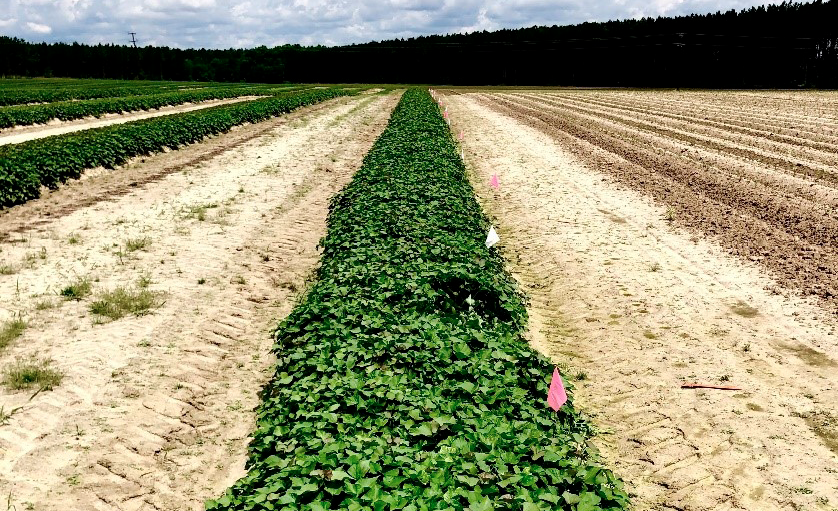
Sweetpotato bed. (Photo by Mark Shankle)
Agronomy
Evaluating sweetpotato varieties for their allelopathic effects on growth of different weed species under field conditions
Varsha Singh, Isabel Werle, Mark W. Shankle, Stephen L. Meyers, and Te-Ming Tseng
A study was conducted at Pontotoc and Starkville locations in Mississippi under field conditions to determine the allelopathic effect of sweetpotato varieties on weed density. Five sweetpotato varieties (Heart-O-Gold, Centennial, Hatteras, Morado, and 529) that showed allelopathic suppression of weeds in a greenhouse experiment plus a standard commercial cultivar, Beauregard (B14), were planted in two-row plots with four replications at both locations. At three weeks after transplanting, seeds of three weed species (Palmer amaranth, yellow nutsedge, and goosegrass) were sown in between the rows of all the plots. Weed cover by weed species, including native weeds present in the field, was recorded at 14, 21, and 28 days after sowing (DAS) of the weed seeds.
Results showed that at 14 DAS, only native weeds could grow in the plots. Even at 21 and 28 DAS, the growth of other native weeds was 20-90% higher than the three studied weeds in plots at both locations. Analysis of variance showed that at 21 and 28 DAS, only broadleaf signalgrass cover was significantly variable in the presence of different sweetpotato varieties. The overall weed density reduction (%) compared to the weed control plot after 21 DAS for both the locations illustrated that varieties Morado and 529 reduced weeds by more than 65%. In the presence of the five varieties, the overall weed density at the Starkville location was lower than the commercial variety Beauregard. At the Pontotoc location, weed density was highest in the presence of variety Heart-O-Gold, followed by Beauregard. Results from this study will help identify sweetpotato varieties with the potential to suppress weed growth, which can be useful for breeding cultivars designed for organic production systems.
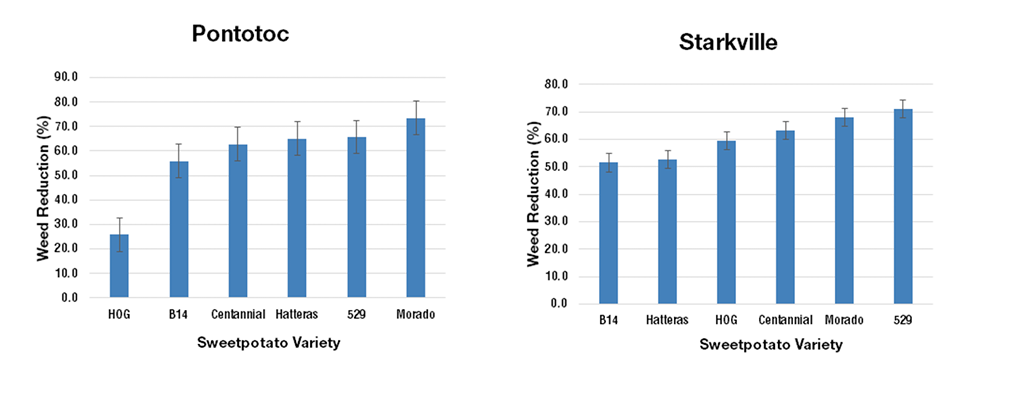
Figures 1 & 2. Reduction (%) of overall weed density in presence of different sweetpotato varieties compared to the weed control plot at 21 days after sowing at Pontotoc and Starkville location

Beef Cattle
Impact of Cu, Co, Mn, and Zn supplementation during the backgrounding phase on productive and health responses of cattle
Kelsey Harvey, Libby Durst, Logan Rahmel, and Brandi Karisch
The stocker/backgrounding segment of the beef industry feedyards contain large lots of uniformly sized, immunocompetent weaned feeder cattle that have been acclimated to feed bunks and water troughs, preparing cattle to thrive in intensive feeding systems. However, calves that are received into these programs experience variable degrees of psychological and physiological stressors including weaning, transport, commingling with different animals, and exposure to novel diets and management. An example of a specific nutritional approach to optimize cattle productivity is Cu, Co, Mn, and Zn supplementation, which play vital roles in physiological mechanisms necessary for growth, health, and stress responses in cattle. Moreover, supplementing organic complexed Cu, Co, Mn, and Zn to newly arrived stocker cattle may be of further benefit based on their enhanced absorption, retention, and biological activity compared to their inorganic counterparts.
Trace mineral status of newly received assembled calves is unknown, with subclinical deficiencies possible in cattle sourced from multiple origins. In one such case, steers were sourced from a Virginia feeder cattle sale, for one year of a grazing study, with a large range in initial liver Cu (3.4 to 67.3 mg/kg,). Only 22% of these steers entered the study with normal liver Cu levels. Research is limited investigating impact of Cu, Co, Mn, and Zn supplementation to high stress cattle prior to feedlot arrival, and warrants investigation, therefore, we aim to determine the impacts of Cu, Co, Mn, and Zn supplementation (either as organic or inorganic sources) to beef calves received into a backgrounding calf system on productive, immune, and physiologic parameters of cattle through a 60-day backgrounding phase and, following dietary intervention, during a post-transport feedlot receiving phase. At the completion of this research, we expect to determine whether supplementing organic complexed Cu, Co, Mn, and Zn to newly received cattle positively impacts cattle performance and immunocompetence. Further we anticipate providing preliminary information regarding the initial liver mineral status of newly received cattle and subsequent impacts on cattle performance and health.
_-_Impact_-_Feeding1.png)
Supplementing cattle with Cu, Co, Mn, and Zn. (Photo by Kelsey Harvey)
_-_Impact_-_Growsafe.png)
Calf using a GrowSafe feed intake system which measures the amount of food consumed. (Photo by Kelsey Harvey)
Horticulture
Lettuce Biomass Accumulation and Phytonutrient Concentrations are influenced by Nitrogen, Cultivar, and Growing Location
T. Casey Barickman, Thomas Horgan, and Skyler Brazel
A major cause of the decrease in yield and quality of lettuce, a cool-weather crop, is inflorescence initiation response to high temperatures. The ability to grow lettuce during high temperatures could result in an overall increase in production of lettuce, allowing it to be grown through the summer in regions where high temperatures limit production. The purpose of this research was to determine how increasing levels of nitrogen (N) fertilizer, location, and lettuce cultivars affect the yield, biomass accumulation, and phenolic acid, flavonoid, and anthocyanin concentrations in lettuce grown during summer temperatures. This study was carried out at two sites, the MAFES Northeast Mississippi Branch Experiment Station (NEMBES) and Northwest Washington Research and Extension Center (NWREC). The experiment was a randomized complete block design arranged in a 2 (cultivar) x 2 (location) x 4 (N rate) factorial with 4 replications. Treatments included two cos (romaine) lettuce cultivars, ‘Salvius’ and ‘Thurinus’. Nitrogen treatments included 42 (1x), 63 (1.5x), 105 (2.5x) and 189 (3.5x) kg·ha-1. Lettuce plants were transplanted on May 6, 2016 at NEMBES and June 14, 2016 at NWREC. Results indicated no significant differences in lettuce yield and biomass accumulation with increasing N treatments. ‘Salvius’ had a significant increase in fresh mass (FM) and dry mass (DM), and the DM:FM ratio when compared to ‘Thurinus’. Additionally, the NWREC location had higher lettuce FM and DM. There were no significant differences in phenolic acid, flavonoids, and anthocyanin concentrations with N treatments, except for quercetin-3-glucoside (Q-3-G). The flavonoid Q-3-G increased significantly with increasing N concentrations. There were interactions between location and lettuce cultivar for chlorogenic acid, Q-3-G, and quercetin/luteolin glucuronide (QL-G). In general, there was increased chlorogenic acid content in ‘Salvius’ at the NEMBES location and increased concentrations of Q-3-G and QL-G in ‘Thurinus’ at the NWREC location. The lettuce cultivar ‘Thurinus’ had significantly more chicoric acid and quercetin-malonyl-glucoside (QM-G) when compared to ‘Salvius’. Furthermore, the lettuce grown at NWREC location had significantly more chicoric acid and cyandidan-3-glucoside (C-3-G). Overall, lettuce grown at the NWREC location and the cultivar ‘Salvius’ had greater yields and biomass accumulation. Lettuce grown at the NWREC location also had greater amounts of phenolic acids, flavonoids, and anthocyanin except for chlorogenic acid. The cultivar ‘Salvius’ had greater amounts of phenolic acids and ‘Thurinus’ had greater amounts of flavonoids and anthocyanins.
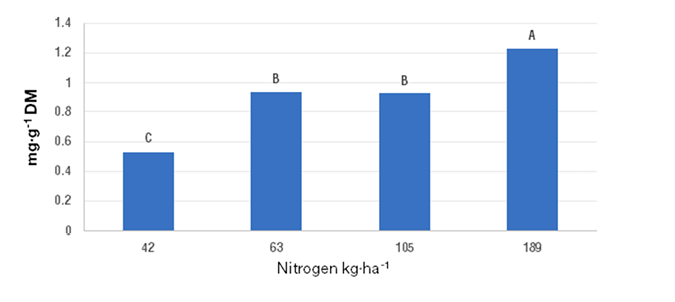
Figure 1. The effect of increasing nitrogen fertilization on the concentration of quercetin-3-glucoside concentrations in leaf tissue of ‘Salvius’ and ‘Thurinus’, red and green romaine lettuce cultivars. Values followed by the same letter are not significantly different at P ≤ 0.05 according to Fisher’s protected least significant difference test.

Table 1. Fresh mass (FM, g), dry mass (DM, g), and the ratio of DM to FM as affected by lettuce cultivar and growing location.
| Fresh Mass (g) | Dry Mass (g) | DM:FM Ratio | |
|---|---|---|---|
|
Cultivar |
|||
| Salvius |
599.89 ay |
31.55 a |
0.05 b |
| Thurinus |
267.80 b |
16.64 b |
0.06 a |
| Locationz | |||
| NEMBS |
400.42 b |
22.06 b |
0.06 a |
| NWREC |
467.27 a |
22.13 a |
0.06 a |
y Values of the same column for the same main effect (cultivar or location) followed by the same letter are not significantly different at P ≤ 0.05 according to Fisher’s protected least significant difference test.
z MAFES Northeast Mississippi Branch Experiment Station (NEMBES), Verona, MS and Washington State University’s Northwest Washington Research and Extension Center (NWREC), Mount Vernon, WA.
Horticulture
Elevated Levels of Potassium in Greenhouse Grown Red Romaine Lettuce Impacts Mineral Nutrient and Soluble Sugar Concentrations
T. Casey Barickman, Thomas Horgan, and Skyler Brazel
Lettuce is one of the major crops of the United States and can provide a large portion of income for small to medium size growers. Growing lettuce in adverse environmental conditions can have negative effects on quality. Elevated levels of potassium (K) have been shown to positively influence quality in various fruit and vegetables, such as tomato, pepper, and strawberry. However, research is lacking on the effects of elevated levels of K on leafy vegetables such as lettuce. Therefore, seeds of ‘Cimmaron’ lettuce were sown into a soilless medium and grown in greenhouse conditions at 25/20 °C (day/night). At 27 days after seeding, the plantlets were transferred to 3.8 L plastic nursery pots. Plants were grown under increasing K treatments of 98 (control), 185 (2x), 370 (3x), and 740 (8x) kg·ha-1. Plants were harvested 56 days after seeding. Application of elevated levels of K fertilizer treatments in red romaine lettuce had a positive quadratic effect on plant height increasing 7.0% from the control. Fresh mass increased 13.0% from the control and dry mass increased 15.5%. There was positive linear increase of 30.0% in sucrose concentrations in lettuce leaf tissue. In addition, the increase in K treatments caused an increase of 43.3% in K concentrations in the leaf tissue. In other nutrients, such as Ca, Mg, and S there was a decrease in the leaf tissue of 61%, 52%, and 46% when compared to the control treatment, respectively. The results of the current study suggest that increasing K fertilizer to 185 kg·ha-1 has the best results for plant height, fresh and dry mass, and mineral nutrient concentrations. This study may initiate research that could examine the effects of increasing K fertilizer levels in lettuce or other leafy green vegetables on antioxidant levels and postharvest storability.
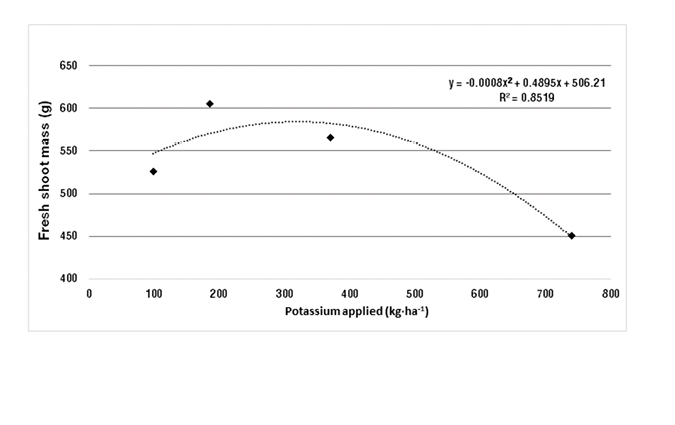
Figure 1. The effect of adequate and elevated levels of potassium on fresh mass of greenhouse grown red romaine lettuce plants harvested 56 days after seeding. Means with the same letter are not significantly different at the P ≤ 0.05 level using Fisher’s Least Significant Difference (LSD).
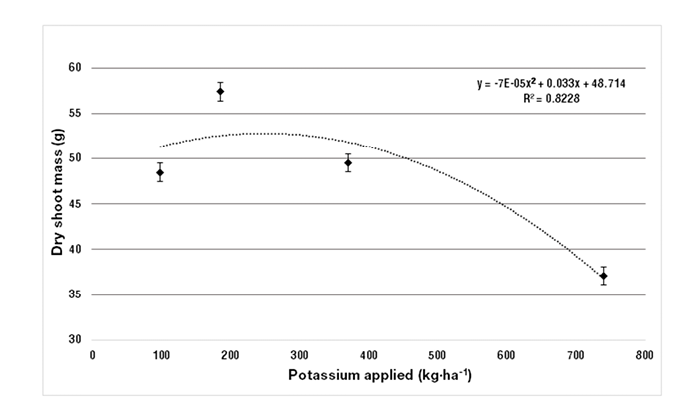
Figure 2. The effect of adequate and elevated levels of potassium on dry mass of greenhouse grown red romaine lettuce plants harvested 56 days after seeding. Means with the same letter are not significantly different at the P ≤ 0.05 level using Fisher’s Least Significant Difference (LSD).
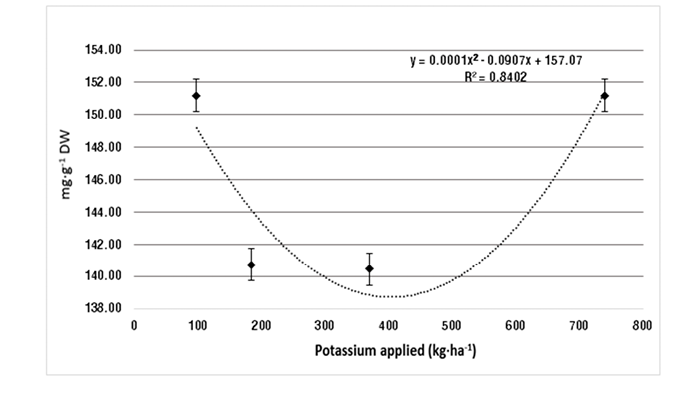
Figure 3. Total soluble sugar concentrations of greenhouse grown red romaine lettuce plants treated with adequate and elevated potassium levels and harvested 56 days after seeding. Means with the same letter are not significantly different at the P ≤ 0.05 level using Fisher’s Least Significant Difference (LSD).
Table 1. Elemental nutrient concentrations of greenhouse grown ‘Cimmaron’ red romaine lettuce plants at adequate and elevated levels of potassium.
|
Elemental Nutrient Concentrations (mg·g-1 Dry Mass)ab |
||||||||||||
|
Potassium |
Na |
Mg |
P |
S |
K |
Ca |
B |
Mn |
Fe |
Cu |
Zn |
Moc |
|---|---|---|---|---|---|---|---|---|---|---|---|---|
|
98.61 |
1.45 |
6.07 |
4.80 |
3.27 |
31.54 |
10.13 |
0.03 |
0.22 |
0.40 |
0.02 |
0.07 |
0.03 |
|
185.17 |
1.19 |
6.51 |
5.40 |
2.53 |
48.80 |
10.65 |
0.03 |
0.30 |
0.55 |
0.05 |
0.09 |
0.04 |
|
370.34 |
0.98 |
4.59 |
5.86 |
2.37 |
55.68 |
6.66 |
0.03 |
0.22 |
0.35 |
0.02 |
0.08 |
0.03 |
|
740.53 |
0.87 |
2.91 |
4.87 |
1.75 |
53.03 |
3.95 |
0.02 |
0.13 |
0.23 |
0.02 |
0.06 |
0.02 |
|
Contrastd |
||||||||||||
|
Linear |
* |
** |
ns |
** |
** |
** |
** |
ns |
* |
ns |
ns |
ns |
|
Quadratic |
ns |
ns |
ns |
ns |
* |
ns |
* |
* |
ns |
* |
*** |
ns |
a Abbreviations: Na-Sodium; Mg-Magnesium; P-Phosphorus; S-Sulfur; K-Potassium; Ca-Calcium; B-Boron; Mn-Manganese; Fe-Iron; Cu-Copper; Zn-Zinc; Mo-Molybdenum
b The standard error of the mean was Na ± 0.16; Mg ± 0.70; P ± 0.50; S ± 0.31; K ± 4.65; Ca ± 1.41; B ± 0.002; Mn ± 0.04; Fe ± 0.08; Cu ± 0.007; Zn ± 0.005; Mo ± 0.01
c Mo given as µg·g-1 Dry Mass.
d ns, *, **, *** indicate non-significant or significant at P ≤ 0.05, 0.01, 0.001, respectively.
Horticulture
The standard recommendation for tomatoes from the Mississippi State University Soil Testing Lab is 120 lbs of actual nitrogen per acre (N/ac). A number of Mississippi growers and extension agents have questioned if this was adequate. In the Vegetable Crop Handbook for Southeastern United States 200.5 lbs of N/ac is the recommended rate. This study was conducted to determine yield differences from the nitrogen rates of 0, 50, 100, 150, and 200 lbs N/ac applied in split applications to 3 tomato varieties, field grown in north Mississippi. Rocky Top, Cherokee Purple, and Big Beef tomato varieties were grown in northern Mississippi. The experimental design was a randomized complete block with four replications. Each replication consisted of 6 plants with the middle 4 harvested for data. Raised beds were formed, 6 inches high and 30 inches across the top, with a press-pan-type bed shaper that installs drip-tape as the bed is formed. Plants were irrigated to apply approximately 1 acre inch (27,000 gal/ac) of water/week minus rainfall. Plants were spaced 2 ft. apart in the row and rows were on 8 ft. centers. Plants were greenhouse seeded the 1st week of July and transplanted to the raised beds the last week of July. A rebar/tomato stake was driven between every two plants for support and the Florida weave trellising technique was used. Ammonia nitrate was the nitrogen source. All plots received one-half the assigned nitrogen rate 7 days after transplant (DAT), ¼ rate was applied 27 DAT, and the final ¼ rate was applied 48 DAT. No lime or P was required but all the K, 180 lbs/ac of 0-0-60, was applied pre-plant according to Mississippi State Soil Testing Laboratory recommendations. A motorized backpack mist sprayer was used for insect and disease control. The insecticides Asana, Warrior, Insecticidal Soap, and Bt (Bacillus thuringensis), were mixed with the fungicides Bravo WS, Quadris, or Kocide and sprayed every 7-10 days. Harvest began early October and every 3-5 days until the last harvest after the first killing frost in early to mid-November. Total per plant yields of the 200 and 150 lbs N/ac rates were significantly greater than the 50 and 0 lbs N/ac but not greater than 100 lbs N/ac which had the highest total number (24.3) of tomatoes. The total number of the 200 and 100 lbs N/ac rates were significantly greater than the 0 and 50 lbs N/ac but not the 150 lbs N/ac. The 5 nitrogen rates had no significant yield effect on the weight or number of the Jumbo grade however in the extra-large grade 200 and 100 lbs N/ac out produced 50 and 0 lbs N/ac. Rocky Top yielded the most Jumbo, Big Beef yielded the most Extra Large with Cherokee Purple being intermediate. Cherokee Purple, an heirloom variety, produced many severely cracked and misshaped culls. Over 95% of the marketable yields were the jumbo and extra-large grades therefore the large and medium grade data was not included here. The data indicated that there may have been adequate levels of N in the soil where the tomato research plot was located, which was a pumpkin field in 2013. Thus, in 2014 data was inclusive for the 5 N treatments. Overall, data indicated that a soil test, including a test for total N, may be needed to accurately calculate the amount of N to add to tomato fields.
Effects of Nitrogen on Tomato Yield
T. Casey Barickman, Thomas Horgan, and Skyler Brazel
Table 1. Total marketable weight and number of tomato fruit with five levels of nitrogen fertilizer rates.
|
Treatment lbs N/ac |
Total Weight (lbs) |
Total Number |
Jumbo Weight (lbs) |
Jumbo Number (#) |
Ex-Large Weight (lbs) |
Ex-Large Number (#) |
||||||
|---|---|---|---|---|---|---|---|---|---|---|---|---|
|
Year 1 |
Year 2 |
Year 1 |
Year 2 |
Year 1 |
Year 2 |
2013 |
2014 |
2013 |
2014 |
2013 |
2014 |
|
|
200 |
13.9 a |
15.0 a |
24.1 a |
28.2 a |
6.7 a |
6.3 a |
8.9 a |
7.8 a |
6.1 a |
6.0 a |
12.3 a |
12.0 a |
|
150 |
13.7 a |
14.7 a |
22.0 ab |
28.2 a |
6.5 a |
5.7 a |
8.6 a |
7.1 a |
5.6 ab |
6.1 a |
11.1 ab |
12.3 a |
|
100 |
12.9 ab |
14.8 a |
24.3 a |
25.2 a |
6.4 a |
6.0 a |
8.6 a |
7.7 a |
6.5 a |
6.2 a |
12.8 a |
12.1 a |
|
50 |
12.2 bc |
14.5 a |
20.6 b |
27.2 a |
6.7 a |
5.3 a |
8.9 a |
6.5 a |
4.8 b |
6.3 a |
9.5 b |
11.6 a |
|
0 |
11.0 c |
13.2 a |
18.9 b |
24.9 a |
5.7 a |
4.7 a |
7.5 a |
5.8 a |
4.7 b |
6.2 a |
9.4 b |
12.0 a |
Y Means sharing the same letter, within a column, were not significantly different. lsd at P=0.05.
Magnolia Botanical Gardens
Jeff Wilson and Susan Worthey
The Magnolia Botanical Gardens were designed and installed in 1997. It serves as a demonstration and educational resource for green industry professionals and consumers. Plant evaluations and educational programs held in the MBG have increased landscape success for homeowners and supported horticulture businesses statewide.
Gardening for beginners has been on a steady rise in recent years. Recent surveys found more Americans are gardening and spending more than ever before. Food (36%) and flower (34%) gardening were the most popular activities with about 1/3 of households participating. Households spent an estimated $3.6 billion growing vegetables, fruit, berries and herbs and $2.7 billion on flowers.
These gardeners have numerous avenues to find their needed horticultural information (Cohen, 2015) and are seeking more information and programming from the Extension Service. Providing these gardeners with a location to learn which plant materials are best suited for their growing regions is a must. Educational outreach programming at the Magnolia Botanical Gardens (Verona, MS) and through social media was used to teach sustainable practices and technologies that could be implemented in home landscapes and gardens.
Clientele were homeowners, Master Gardeners, and other adult consumers who wanted to learn about the benefits of specialty crops (aesthetic, culinary, nutritional, sustainability) and how to install and manage them in home landscapes. An informed public will make better choices and be more successful in the purchase, care and use of ornamental, fruit, vegetable, and herb specialty crops. This will indirectly have a positive impact on the green industry in Mississippi through horticultural purchases (Drake & Lawson, 2015).
A 2017 MDAC Specialty Crop Block Grant in the amount of $45,057 funded the revitalization of the MBG. The grant renewed the existing MBG by incorporating diverse specialty crops and focusing on sustainable practices that could be implemented in home landscapes/gardens; it increased gardeners’ knowledge by providing programs in sustainable gardening using MBG as an outdoor classroom; and it increased use and consumption of specialty crops by homeowners.
Numerous research projects are conducted in the MBG, including a study on the Efficacy of using additional potassium on Zinnia (Zinnia elegans) cut flower production. A study was funded ($17,949) by the MDAC Specialty Crop Block Grant in late 2021 titled Evaluating native Christmas tree species production in North Mississippi. This work will cover 5 years and will help growers learn more efficient production methods. A Vegetable Variety Trial and a Rose Variety Trial will be installed in 2022 as well. Future reports will cover these results.
Cohen, P. 2015. National Gardening Survey. https://gardenresearch.com
Drake, L. & L. Lawson. 2015. Best practices in community garden management to address participation, water access, and outreach. The Journal of Extension 53(6):v53-6a3. https://joe.org/joe/2015december/a3.php
_-_Magnolia_-_Educational_program.png)
Horticulture
Mississippi Master Gardener Volunteer Program
Jeff Wilson
The Master Gardener (MG) Volunteer Program has been growing strong in MS since 1992. This past year completed 30 years as a program that has more than 1600 active MGs covering 58 counties. The MG program is a major contributor to MSU Extension’s ability to meet its ever-growing consumer horticulture needs. MGs assist Extension agents and specialists statewide to provide research-based educational programs and information to improve the economic, social, and cultural well-being of all Mississippians.
MG Trainees (Interns) receive 40 hours of classroom/online instruction. Sections taught are introduction, botany, soils, weeds, honeybee care, propagation, urban trees, ornamentals, lawns, entomology, diseases, fruits & nuts, vegetables, and volunteerism. Interns then pass a 100+ question exam to complete the initial training.
Interns then volunteer 40 service hours to complete the certification process. To maintain active MG status, they volunteer a minimum of 20 service and 12 education hours each year thereafter.
In 2021, 266 participants registered for the first ever online MG training with 214 fully completing the training. This was an 80% completion rate! Overall, 755 MGs entered 53,777 volunteer hours into the reporting system. Volunteers from 52 of the 82 counties entered hours into the reporting system. MGs volunteered enough time to be equivalent to 26 full-time employees. Their volunteer service is equivalent to $1.37 million dollars.
Master Gardeners make a difference in the lives of Mississippians in local communities. They provide horticulture education to teach clients how to garden efficiently and safely. They promote buying plants and supplies from Mississippi producers to support the green industry statewide. MGs use horticulture to encourage gardeners to be more active and develop a healthier lifestyle. MS Master Gardeners are truly using this Volunteer Training to make a difference for Extension and all Mississippians!
Mississippi Master Gardner Volunteers work in a local landscape. (Photo by Jeff Wilson)
Table 1. Results of Master Gardener Volunteerism for 2021.
|
# Of MGs |
Dollar Value ($) |
|
|---|---|---|
|
Master Gardeners |
755 |
|
|
Times Volunteered |
19,363 |
|
|
Contacts |
55,678 |
|
|
Miles Driven |
295,829 |
$ 170,102 |
|
Education Hours |
14,273 |
$ 632,701 |
|
Service Hours |
39,514 |
$ 1,004,845 |
|
Total Hours |
53,777 |
$ 1,367,546 |
_-_MS_Master_-_Master_Gardener_Volunteer_Programs.png)


